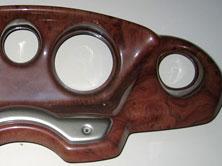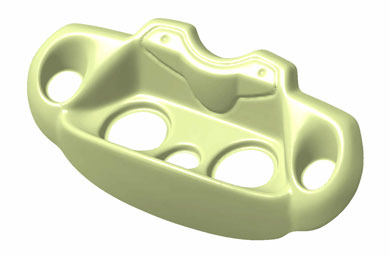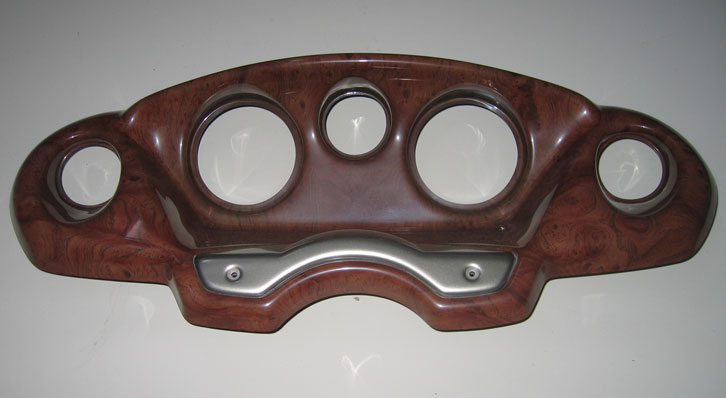Besides offering a complete line of tools for graphic arts and the technical support for these products, Techno-Gestass is a player in the car tuning market niche. As it happens, Techno-Gestass recently engaged the services of Creaform for a “customized” overhauling project.
The project
Techno-Gestass wanted to do the reverse engineering of an existing dashboard, so to create a new mold that would allow them to manufacture dashboards in complete accordance with its clients’ taste and requests: more stylish, in various colors or made out of other materials than the original. To do so, and since it was obviously impossible to obtain the CAD file from the automotive manufacturer, a high quality surface file of the part (.iges) had to be created in order to tool the new dashboard.
The main difficulties faced by Techno-Gestass with this project could be summed up in a couple of questions:
Which process would enable us to duplicate a quality piece with a machine-tool to do it?
What would be the most cost-effective option? Do it in-house, or have it done by an external firm?
Techno-Gestass undertook the targeting of the method and technology that would be most appropriate and effective for its business. Rather quickly, it became obvious that the best option would be to 3D scan the dashboard first, and then reverse engineer it in order to generate digital data files compatible with the machines-tools used by the company. Techno-Gestass also chose to trust a 3D scanning and reverse engineering expert company to do the work: Creaform, the developer and manufacturer of the Handyscan 3D line-up of self-positioning handheld laser scanners.
From the 3D scanning standpoint, these revolutionary and highly accurate scanners allow for quick scanning of objects, and directly generate mesh surface file (rather that a point cloud), which greatly reduces the post-treatment time. Besides, this technology guarantees high accuracy measures, which ensures the perfect fit between the reverse engineered dashboard and the other components of the car’s interior.
After balancing the different options, Techno-Gestass chose a turnkey reverse engineering service – provided by Creaform’s experts – convinced by the assurance of superior quality work and by the fact that this solution was clearly the way to go to reduce production lead time and costs.
 Scanning the dashboard
Scanning the dashboard
Once both parties had agreed on a course of action, Techno-Gestass shipped the dashboard to Creaform’s laboratory located in Lévis, Québec. The 3D scanning specialists first scanned the dashboard with a Handyscan 3D self-positioning handheld laser scanner. After that, the .stl file generated was cleaned, and the surface was generated in .iges format. In this particular case, Techno-Gestass needed .iges files in order to tool the part (or the mold used to duplicate the part), but Creaform can generate output files in various CAD formats, generic or native, following the client’s needs.
And if not, what??
Without the quick, contactless and accurate Handyscan 3D technology, it would have been necessary to use a traditional manual measuring technique, and to try and reproduce the shapes with these measures and the physical part. This method would have required a lot of time and would not have allowed exact duplication of the shapes, especially since the part in question was non prismatic, which would have led to increases risks of poor assembling between the duplicated part and the rest of the structure.
The Handyscan 3D benefits
The Handyscan 3D scanners allow for great time savings. For instance, the time required to generate the dashboard surface was reduced by 66%.
Furthermore, 3D scanning ensures results that are true to the original part, and guarantees a perfect fit with the car’s other components, which is hardly possible with traditional hand measuring and modeling.
In this case and because of time constraints, Techno-Gestass chose Creaform’s 3D scanning expert services, but the Handyscan 3D technology is so easy to learn and use that an employee from Techno-Gestass could have done the work directly at the shop, following a short, 1-hour training.
Conclusion
This project is the perfect example of excellent ROI. By choosing a turnkey scanning service, Techno-Gestass invested in the purchase of digital files that can be reused as many times as necessary and that allow the company to ensure a perfect fit of the car’s components. As an indirect result, the company could also reduce installation and labor costs drastically. Overall, Techno-Gestass succeeded in diversifying its product offer, and satisfying a wider clientele.


 Scanning the dashboard
Scanning the dashboard



